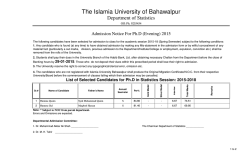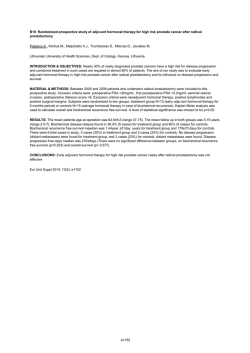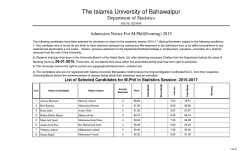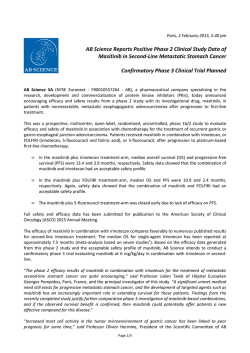
Survival for Patients With HIV Admitted to the ICU Continues to
CHEST Original Research CRITICAL CARE MEDICINE Survival for Patients With HIV Admitted to the ICU Continues to Improve in the Current Era of Combination Antiretroviral Therapy* Krista Powell, MD, MPH; J. Lucian Davis, MD, MAS; Alison M. Morris, MD, MS; Amy Chi, MD; Matthew R. Bensley, RN; and Laurence Huang, MD, FCCP Background: The combination antiretroviral therapy (ART) era (1996 to the present) has been associated with improved survival among HIV-infected outpatients, but ICU data from 2000 to the present are limited. Methods: We conducted a retrospective study of HIV-infected adults who had been admitted to the ICU at San Francisco General Hospital (from 2000 to 2004). The primary outcome was survival to hospital discharge. Results: During the 5-year study period, there were 311 ICU admissions for 281 patients. Respiratory failure remained the most common indication for ICU admission (42% overall), but the proportion of patients with respiratory failure decreased each year from 52 to 34% (p ؍0.02). Hospital survival ratios significantly increased during the 5-year period (p ؍0.001). ART use at ICU admission was not associated with survival, but it was associated with higher CD4 cell counts, lower plasma HIV RNA levels, higher serum albumin levels, and lower proportions with AIDS-associated ICU admission diagnoses and with Pneumocystis pneumonia. In a multivariate analysis, a higher serum albumin level (adjusted odds ratio ͓AOR͔, 2.08; 95% confidence interval ͓CI͔, 1.41 to 3.06; p ؍0.002) and the absence of mechanical ventilation (AOR, 6.11; 95% CI, 2.73 to 13.72; p < 0.001) were associated with survival. Conclusions: In this sixth in a series of consecutive studies started in 1981, we found that the epidemiology of ICU admission diagnoses continues to change. Our study also found that survival for critically ill HIV-infected patients continues to improve in the current era of ART. Although ART use was not associated with survival, it was associated with predictors that were associated with survival in a multivariate analysis. (CHEST 2009; 135:11–17) Key words: AIDS; antiretroviral therapy; HIV; intensive care; mechanical ventilation; outcomes; respiratory failure Abbreviations: APACHE ϭ acute physiology and chronic health evaluation; ART ϭ antiretroviral therapy; PCP ϭ Pneumocystis pneumonia; SFGH ϭ San Francisco General Hospital of HIV protease inhibitors in T he1996introduction heralded the combination antiretroviral therapy (ART) era and was associated with improved survival among HIV-infected outpatients.1 Studies2,3 from San Francisco during this early period (from 1996 to 1999) found that the use of ART was also associated with improved survival among HIV-infected patients who were admitted to the ICU. However, more recent studies4 –7 from New York and London found that the survival of these patients was independent of ART, raising the question of whether www.chestjournal.org Downloaded From: http://journal.publications.chestnet.org/ on 02/06/2015 ART use is associated with survival in the current period. In the absence of prospective randomized clinical trials to guide the intensive care of HIVinfected patients, outcome-focused observational studies can provide important information.8 For editorial comment see page 1 ICU admission diagnoses and survival among HIV-infected patients have changed throughout the HIV epidemic. In the 1980s and early-to-mid 1990s, CHEST / 135 / 1 / JANUARY, 2009 11 Pneumocystis pneumonia (PCP) was responsible for a high burden of disease, and survival was low9 –15; later studies2,3,16,17 demonstrated improved survival, even among PCP patients. Although respiratory failure has remained the most common indication for ICU admission,2,5,7 PCP incidence has decreased.4,17 In the early ART era (from 1996 to 1999), ICU admissions due to HIV-associated conditions decreased.18 However, few studies6,7,19 have reported on the current ART era (2000 to the present), and it is unknown whether ICU admission diagnoses and survival continue to change. Therefore, we conducted a retrospective cohort study of HIV-infected patients who had been admitted to the ICU at San Francisco General Hospital (SFGH) in the current ART era. Our goals were to identify trends in ICU admission diagnoses and survival, to compare clinical characteristics and outcomes in patients according to ART use, and to determine the predictors of survival in the current ART era. Earlier results of this study were presented in abstract form.20 admissions using the International Classification of Diseases, ninth revision, diagnostic code for HIV (042) identified patients with HIV who had been admitted to the ICU. The University of California, San Francisco, Committee on Human Research approved the study protocol. Data Collection Investigators (K.P., L.D., and A.C.) reviewed the medical records of patients using standardized chart abstraction forms.2,17 If patients were readmitted to the ICU during the same hospitalization, only the data from the first admission were recorded. ICU admission diagnoses and AIDS-associated illnesses were classified using a predetermined list that was identical to those used in prior studies.2,17 ART was defined as the use of at least two classes of antiretroviral drugs21 at the time of hospital admission. Clinical information included demographics, CD4 count, plasma HIV RNA level if available within 6 months of hospital admission (usually available within 1 month), serum albumin level within 1 week of hospital admission, and the need for invasive mechanical ventilation. We calculated the acute physiology and chronic health evaluation (APACHE) II scores.22 The primary outcome was survival to hospital discharge. The data were entered into a customized database (Access 2003; Microsoft; Redmond, WA) and were subjected to electronic validation rules. Statistical Analysis Materials and Methods Study Design and Subjects We conducted a retrospective cohort study of all HIV-infected adults who had been admitted to the ICU at SFGH from 2000 through 2004. SFGH is an urban public hospital, with 375 beds and 30 ICU beds. A computerized search of SFGH ICU *From the Department of Medicine (Drs. Powell, Davis, and Huang), University of California San Francisco, San Francisco, CA; the HIV/AIDS Division (Mr. Bensley), San Francisco General Hospital, San Francisco, CA; the Division of Pulmonary and Critical Care Medicine (Dr. Morris), University of Pittsburgh, Pittsburgh, PA; and the Division of Pulmonary and Critical Care Medicine (Dr. Chi), Boston University, Boston, MA. The contents of this study are solely the responsibility of the authors and do not necessarily represent the official view of the National Center for Research Resources of the National Institutes of Health. Information on the National Center for Research Resources is available at http://www.ncrr.nih.gov/. Information on Re-engineering the Clinical Research Enterprise can be obtained from http://nihroadmap.nih.gov/clinicalresearch/overviewtranslational.asp. This research was funded by NIH grants 1F32HL088990 (J.L.D.), 1R01HL090339 (A.M.), 5K24HL087713 (L.H.), and 1R01HL090335 (L.H.). This project was also supported by grant No. 1 UL1 RR024131– 01 from the National Center for Research Resources, a component of the NIH, and by the NIH Roadmap for Medical Research. The authors have reported to the ACCP that no significant conflicts of interest exist with any companies/organizations whose products or services may be discussed in this article. Manuscript received April 11, 2008; revision accepted July 16, 2008. Reproduction of this article is prohibited without written permission from the American College of Chest Physicians (www.chestjournal. org/misc/reprints.shtml). Correspondence to: Krista Powell, MD, MPH, HIV/AIDS Division, Ward 84, San Francisco General Hospital, 995 Potrero Ave, San Francisco, CA 94110; e-mail: [email protected] DOI: 10.1378/chest.08-0980 12 Downloaded From: http://journal.publications.chestnet.org/ on 02/06/2015 A statistical software package (SAS, version 9.0; SAS Institute; Cary, NC) was used for statistical analysis. Statistical significance was predetermined in reference to a p value of Ͻ 0.05. Continuous data were compared using the Student t test or the Wilcoxon rank sum test, and comparisons of frequencies were made with the 2 test or Fisher exact test. We used linear regression to assess trends in the yearly proportions of patients with each characteristic of interest (ie, ICU admission diagnosis, diagnosis of an AIDS-associated illness or PCP, the use of ART at ICU admission, and survival). To describe the epidemiology of patients in the current era, we compared patient characteristics according to the use of ART at hospital admission. To identify predictors of survival, we compared survivors with nonsurvivors. Unadjusted odds ratios for survival were computed for each candidate variable. Variables with p values Ͻ 0.20 for the appropriate test were included in model-building procedures in logistic regression.23 Subset selection and backward-elimination multivariate logistic regression were used to determine the most parsimonious variables, using all available data. Final model fit was assessed using the Hosmer-Lemeshow and specification tests.24 Results There were 311 ICU admissions for 281 patients. Twenty-five patients (9%) had more than one ICU admission during the 5-year study period. Because few patients had repeat ICU admissions, each ICU admission that occurred during a subsequent hospitalization was treated as a separate event. The predictors of survival identified from the multivariate analysis were unchanged if these repeat patient admissions were excluded. Trends in ICU Admission Diagnoses and Survival The annual number of ICU admissions ranged from 50 in 2000 to a peak of 75 in 2002 (Table 1). Original Research Table 1—ICU Admissions, ICU Diagnoses, ART Use, and Survival Among 311 ICU Admissions of HIV-Infected Patients, According to Study Year* Year of Study Enrollment Variables Total 2000 2001 2002 2003 2004 ICU admissions ICU diagnosis Respiratory failure Sepsis Neurologic Other AIDS-associated PCP diagnosis ART use Survival 311 50 52 75 66 68 131 (42) 62 (20) 51 (16) 67 (22) 65 (21) 43 (14) 101 (33) 215 (69) 26 (52) 11 (22) 7 (14) 6 (12) 17 (34) 12 (24) 18 (37) 29 (58) 24 (46) 9 (17) 8 (15) 11 (21) 9 (17) 8 (15) 16 (31) 31 (60) 32 (43) 14 (19) 13 (17) 16 (21) 12 (16) 8 (11) 26 (35) 53 (71) 26 (39) 11 (17) 16 (24) 13 (20) 14 (21) 9 (14) 16 (24) 51 (77) 23 (34) 17 (25) 7 (10) 21 (31) 13 (19) 6 (9) 25 (37) 51 (75) p Value† 0.02 0.17 0.03 0.11 0.001 *Values are given as No. (%), unless otherwise indicated. †Values correspond to the F-statistic for linear regression. A p value Ͻ 0.05 suggests that a linear trend is present. Respiratory failure remained the most common indication for ICU admission (42% overall), but the proportion of patients with respiratory failure decreased each year from 52% in 2000 to 34% in 2004 (p ϭ 0.02). Although the proportion of patients with an AIDS-associated diagnosis plateaued during the study period (p ϭ 0.17), the proportion of patients with PCP significantly decreased from 24 to 9% (p ϭ 0.03). In contrast, hospital survival rates increased over the study period, peaking at 77% in 2003 (p ϭ 0.001), while the proportion of patients receiving ART remained stable (p ϭ 0.11). Patient Characteristics and Use of ART at the Time of Admission Overall, 101 of 306 patients (33%) with available data were using ART at the time of hospital admission (Table 2). This number included six patients who had been admitted to the ICU for complications arising from ART. No patient started receiving ART while in the ICU. Data regarding ART use were unavailable for five patients admitted to the ICU. Patients receiving ART were similar to those not receiving ART with respect to age, gender, race/ ethnicity, and HIV risk factor. Patients receiving ART were more likely than non-ART patients to have a history of HIV-associated opportunistic infection, PCP, and malignancy (p Ͻ 0.05 for all comparisons). ART users had a significantly higher median CD4 count (141 vs 95 cells/L, respectively; p ϭ 0.021) and a significantly lower mean log viral load (3.71 vs 4.81 log copies/mL, respectively; p Ͻ 0.001) than non-ART users. ART patients had significantly higher mean serum albumin levels but similar median serum lactate dehydrogenase levels and median APACHE II scores compared to nonART patients. www.chestjournal.org Downloaded From: http://journal.publications.chestnet.org/ on 02/06/2015 Overall, 21% of patients presented to the ICU with an AIDS-associated diagnosis, two thirds of whom presented with PCP. A significantly lower proportion of patients receiving ART presented with an AIDS-associated ICU admission diagnosis compared to patients not receiving ART (12% vs 25%, respectively; p ϭ 0.008). Similarly, a significantly lower proportion of ART users presented with PCP compared to non-ART users (3% vs 19%, respectively; p Ͻ 0.001). Only three patients who were receiving ART had PCP (7% of 42 PCP cases). Respiratory failure was the most common ICU admission diagnosis for all patients (42%), and was equally frequent among patients receiving ART (40%) and those not receiving ART (44%). PCP was the most common etiology of respiratory failure (28%) but was significantly less frequent among patients receiving ART (8% of ICU admissions for respiratory failure) than among those not receiving ART (38% of ICU admissions for respiratory failure; p ϭ 0.002). Among non-ART users, PCP was the most common cause of respiratory failure. In contrast, among ART users, obstructive airways disease was the most common cause of respiratory failure. Other indications (eg, GI bleeding, cardiac indications, metabolic disorders, traumatic injuries, and postoperative care) were aggregately the second most common indication for ICU admission for patients who were receiving ART (28%). In contrast, sepsis was the second most common indication for ICU admission among patients not receiving ART (22%). Among patients with a diagnosis of sepsis, the etiologic agent was unknown for 40% of patients. Few patients had pneumococcal or staphylococcal infections; these infections accounted for 8% and 13% of sepsis admissions, respectively. The CHEST / 135 / 1 / JANUARY, 2009 13 Table 2—Characteristics of HIV-Infected Patients During 306 Admissions to the ICU at SFGH, 2000 to 2004, According to the Use of ART at the Time of Hospital Admission* Characteristics Age, yr Gender† Male Female Race/ethnicity White African American Other/unknown HIV risk factor MSM IDU Other/unknown Medical history Opportunistic infection PCP Malignancy PCP prophylaxis at time of ICU admission Clinical data CD4 count,‡§ cells/L HIV viral load, copies/mL Albumin,¶ g/dL LDH,§# units/L APACHE II score§** Mechanical ventilation AIDS-associated ICU admission diagnosis PCP diagnosis ICU admission diagnosis Respiratory failure Sepsis Neurologic Other Survival All Patients (n ϭ 306) 44 (24–72) No ART (n ϭ 205) ART (n ϭ 101) 43 (24–71) 46 (25–72) p Value 0.65 0.078 235 (79.7) 60 (20.3) 152 (76.8) 46 (23.2) 83 (85.6) 14 (14.4) 125 (40.9) 115 (37.6) 66 (21.6) 79 (38.5) 77 (37.6) 49 (23.9) 46 (45.5) 38 (37.6) 17 (16.8) 54 (17.7) 170 (55.6) 82 (26.8) 30 (14.6) 118 (57.6) 57 (27.8) 24 (23.8) 52 (51.5) 25 (24.8) 172 (57.7) 63 (21.1) 39 (13.0) 141 (46.5) 104 (52.3) 35 (17.6) 17 (8.5) 69 (33.8) 68 (68.7) 28 (28.3) 22 (22.0) 71 (72.7) 0.007 0.033 0.001 Ͻ0.001 109 (211) 4.47 (1.72) 2.7 (0.8) 320 (288) 22 (14) 205 (67.7) 63 (20.6) 42 (13.8) 95 (213) 4.81 (0.97) 2.6 (0.8) 352 (304) 22 (12) 143 (70.1) 51 (24.9) 39 (19.0) 141(198) 3.71 (1.37) 2.9 (0.9) 449 (223) 22 (16) 62 (62.6) 12 (11.9) 3 (3.0) 0.021 Ͻ0.001 0.006 0.087 0.34 0.19 0.008 Ͻ0.001 130 (42.3) 62 (20.3) 50 (16.3) 64 (21.1) 212 (69.3) 90 (43.9) 45 (22.0) 34 (16.6) 36 (17.6) 144 (70.2) 40 (39.6) 17 (16.8) 16 (15.8) 28 (27.7) 68 (67.3) 0.30 0.14 0.70 *Values are given as mean (range) or No. (%), unless otherwise indicated. LDH ϭ lactate dehydrogenase; MSM ϭ men who have sex with men; IDU ϭ injection drug users. †Eleven ICU admissions for five transgender patients were excluded from gender-stratified analysis. ‡Data were available for 265 ICU admissions. §Values are given as median (interquartile range). Values are given as mean log (SD). Data were available for 211 ICU admissions. ¶Values are given as mean (SD). Data were available for 273 ICU admissions. #Data were available for 184 ICU admissions. **Data were available for 261 ICU admissions. most common etiologic agents identified were Gramnegative rods (18% of ICU admissions for sepsis). The overall survival ratio was high (69%) and was comparable between patients receiving ART and those not receiving ART. Respiratory failure, PCP, and GI bleeding were associated with the lowest rates of survival compared to all other diagnoses (Fig 1). However, the survival rate was Ͼ 50% in every diagnosis category. Predictors of Survival to Hospital Discharge In univariate analyses, there were no differences between survivors and nonsurvivors with respect to age, gender, race/ethnicity, medical history, ART 14 Downloaded From: http://journal.publications.chestnet.org/ on 02/06/2015 use, PCP prophylaxis use, CD4 count, log viral load, or AIDS-associated ICU admission diagnosis (p Ͼ 0.05 for all comparisons). Injection drug users and patients with other/unknown HIV risk factors (eg, heterosexual sex) had increased survival compared to men who have sex with men (Table 3). A higher serum albumin level or lower APACHE II score was associated with survival. In contrast, the need for mechanical ventilation, respiratory failure as an ICU admission diagnosis (compared to all other diagnoses), and PCP (compared to no PCP) were all associated with decreased survival. In multivariate analysis, a higher serum albumin level and the absence of invasive mechanical ventiOriginal Research Figure 1. Proportions of HIV-infected patients surviving 311 hospitalizations in the ICU, by ICU admission diagnosis. Values are given per 100 ICU admissions, with bars displaying SEs. n ϭ number of patients who survived; Post-op ϭ postoperative. lation were associated with survival (Table 3). No interaction was identified between the included covariates. Because of the collinearity between APACHE II scores and albumin level, and between APACHE II scores and invasive mechanical ventilation, we first excluded APACHE II scores from logistic regression modeling. When APACHE II scores were included in the logistic regression, and albumin and invasive mechanical ventilation were excluded due to collinearity, only APACHE II scores remained significantly associated with survival in backward selection. Discussion This study is notable in that it is the sixth in a series of consecutive studies that was started in 1981 to examine the critical care provided to HIV-infected patients at SFGH.2,9,12,13,17 In addition, our study is among the few studies to examine HIV patients who have been admitted to the ICU since the year 2000, and we have noted several important trends. Our study shows that in the current era of ART respiratory failure remains the most common indication for Table 3—Univariate and Multivariate Predictors of Survival to Hospital Discharge in 306 ICU Admissions of HIV-Infected Patients* Variables Unadjusted OR (95% CI) p Value† Adjusted OR (95% CI) p Value‡ No intubation vs invasive mechanical ventilation Albumin, per 1 g/dL increase HIV risk factor IDU vs MSM Other/unknown vs MSM No PCP diagnosis vs diagnosis of PCP in ICU APACHE II score, per 1-point increase Admission diagnosis Sepsis vs respiratory failure Neurologic vs respiratory failure Other diagnoses§ vs respiratory failure 6.34 (3.02–13.1) 2.09 (1.47–2.98) Ͻ 0.001 Ͻ 0.001 6.11 (2.73–13.7) 2.08 (1.41–3.06) Ͻ (0.001) 0.002 2.16 (1.13–4.11) 2.00 (0.97–4.13) 1.99 (1.02–3.90) 0.88 (0.85–0.92) 0.020 0.061 0.044 Ͻ 0.001 NA NA NA NA NA NA NA NA 1.15 (0.60–2.22) 1.77 (0.84–3.74) 3.05 (1.42–6.56) 0.68 0.13 0.004 NA NA NA NA NA NA *CI ϭ confidence interval; OR ϭ odds ratio; NA ϭ not applicable (data for statistically insignificant predictors were not included). See Table 2 for abbreviations not used in the text. †Wald p values correspond to univariate analyses. ‡Wald p values correspond to multivariate model, which excludes APACHE II scores due to collinearity with the included variables. §Other diagnoses include GI bleeding, cardiac conditions, metabolic disorders, trauma, and postoperative care. www.chestjournal.org Downloaded From: http://journal.publications.chestnet.org/ on 02/06/2015 CHEST / 135 / 1 / JANUARY, 2009 15 ICU admission, although the proportion of patients with respiratory failure has decreased. In addition, the proportion of patients with PCP has decreased. Compared to our findings in a previous study,2 AIDS-associated illnesses are less common (decrease, 37 to 21%). While the use of ART has increased since the previous study (from 25 to 33%),2 the yearly proportions of patients receiving ART in our present study remain stable. Although ART use at ICU admission was not associated with survival, it was associated with lower proportions of AIDS-associated ICU admission diagnoses and of PCP, and a higher serum albumin concentrations, which were associated with survival in a multivariate analysis. Finally, our study shows that survival for critically ill HIV-infected patients continues to improve in the current era of ART. The improved survival in our ICU-based study mirrors the trends seen in other ICU cohorts. For example, a study from London7 (from 1999 to 2005), reported an overall hospital survival ratio of 68% in their HIV-infected ICU patients, which was comparable to the overall survival ratio of 65% in their non-HIV general medical ICU patients and was nearly identical to the overall survival ratio in our study (69%). Regrettably, no data were presented in the London study to examine whether hospital survival improved during their study period as it did in our present study. We believe that the improved survival in our study relates at least in part to the decreased proportions of patients with respiratory failure who require invasive mechanical ventilation and to the decreased proportion of patients with PCP. The need for invasive mechanical ventilation and PCP are well-recognized predictors of decreased survival2,5,6 and in our study these diagnoses were associated with among the lowest survival ratios. However, it is also possible that general improvements in ICU care may have contributed to the improved survival. Our study period coincided with the adoption of low tidal volumes for acute lung injury,25 early-goal directed therapy for sepsis,26 and intensive insulin therapy.27 However, we did not record systematically which patients received these interventions, so their potential effects on survival in critically ill HIV-infected patients remain unknown. The improved survival rate in our study appears to be independent of the use of ART. In our study, patients receiving ART had a survival of 67% compared to 70% in those patients not receiving ART. This finding is similar to those from recent studies conducted in New York4 and London.6 In the New York study,4 these survival proportions were 51% compared to 49%, respectively, while in the London study,6 the proportions were 67% compared to 66%, respectively. While the long-term benefits of ART on 16 Downloaded From: http://journal.publications.chestnet.org/ on 02/06/2015 survival among HIV-infected outpatients are indisputable, there may or may not be short-term benefits of ART in ICU patients with a critical illness. Because we did not collect information on the adherence to ART prior to ICU admission, and our observational study did not measure antiretroviral drug resistance, the impact of nonadherence or drug resistance as explanations cannot be excluded. However, it is also possible that the effects of ART are mediated by its impact on CD4 cell count, plasma HIV RNA level, and serum albumin concentration, and, most importantly, by its impact on ICU admission diagnosis (ie, AIDS-associated, including PCP), all of which were associated with ART use in our study. We acknowledge that our study has several limitations. First, we conducted our study at a single institution, in an urban public hospital; since clinical practice and demographics may differ across institutions, the external validity of our study may be limited. However, since we used the same protocol and data collection instrument in this study as in our prior study,2 our comparisons between the earlier ART era and the current era at SFGH are internally valid. Second, we did not follow patients after hospital discharge; therefore, the predictors of longterm survival and any impact of ART on long-term survival remain unknown. Given the retrospective nature of our study design, we chose to focus on survival to hospital discharge, where we had information on all patients, rather than on longer term survival, where we would have had missing data due to losses to follow-up. Third, patients were admitted to the ICU with a broad spectrum of critical illnesses and received heterogeneous treatments, limiting our conclusions regarding the independent effects of any specific treatment or intervention. Studies that examine specific patient subsets (eg, patients with respiratory failure and acute lung injury) are better suited to examine the impact of a specific intervention (eg, low-tidal volume ventilation). Next, measurement error inherent to our study design may have limited our ability to identify an association between CD4 cell count or plasma HIV RNA level and survival, since these potential predictors were obtained at different time points prior to ICU admission. Finally, the observational nature of our study limits any firm conclusions regarding ART use and survival. Patients receiving ART at the time of ICU admission were potentially different than patients not receiving ART with respect to unmeasured characteristics. Despite these limitations, this study of HIVinfected patients who were admitted to the SFGH ICU represents the latest in a consecutive series of studies that started in 1981 and is, to our knowledge, Original Research the only institutional series spanning the entire HIV/AIDS epidemic. We found that survival for critically ill HIV-infected patients continues to improve in the current era of ART. We also found that the improved survival appeared to be independent of the use of ART. In a multivariate analysis, the absence of the need for invasive mechanical ventilation and higher serum albumin levels were both independent predictors associated with improved survival. Further study of critically ill HIV patients may help to confirm these trends. 13 14 15 16 References 1 Palella FJ Jr, Delaney KM, Moorman AC, et al. Declining morbidity and mortality among patients with advanced human immunodeficiency virus infection: HIV Outpatient Study Investigators. N Engl J Med 1998; 338:853– 860 2 Morris A, Creasman J, Turner J, et al. Intensive care of human immunodeficiency virus-infected patients during the era of highly active antiretroviral therapy. Am J Respir Crit Care Med 2002; 166:262–267 3 Morris A, Wachter RM, Luce J, et al. Improved survival with highly active antiretroviral therapy in HIV-infected patients with severe Pneumocystis carinii pneumonia. AIDS 2003; 17:73– 80 4 Narasimhan M, Posner AJ, DePalo VA, et al. Intensive care in patients with HIV infection in the era of highly active antiretroviral therapy. Chest 2004; 125:1800 –1804 5 Khouli H, Afrasiabi A, Shibli M, et al. Outcome of critically ill human immunodeficiency virus-infected patients in the era of highly active antiretroviral therapy. J Intensive Care Med 2005; 20:327–333 6 Miller RF, Allen E, Copas A, et al. Improved survival for HIV infected patients with severe Pneumocystis jirovecii pneumonia is independent of highly active antiretroviral therapy. Thorax 2006; 61:716 –721 7 Dickson SJ, Batson S, Copas AJ, et al. Survival of HIVinfected patients in the intensive care unit in the era of highly active antiretroviral therapy. Thorax 2007; 62:964 –968 8 Huang L, Quartin A, Jones D, et al. Intensive care of patients with HIV infection. N Engl J Med 2006; 355:173–181 9 Wachter RM, Luce JM, Turner J, et al. Intensive care of patients with the acquired immunodeficiency syndrome: outcome and changing patterns of utilization. Am Rev Respir Dis 1986; 134:891– 896 10 Rogers PL, Lane HC, Henderson DK, et al. Admission of AIDS patients to a medical intensive care unit: causes and outcome. Crit Care Med 1989; 17:113–117 11 Luce JM, Wachter RM. Intensive care for patients with the acquired immunodeficiency syndrome. Intensive Care Med 1989; 15:481– 482 12 Wachter RM, Russi MB, Bloch DA, et al. Pneumocystis carinii pneumonia and respiratory failure in AIDS: improved www.chestjournal.org Downloaded From: http://journal.publications.chestnet.org/ on 02/06/2015 17 18 19 20 21 22 23 24 25 26 27 outcomes and increased use of intensive care units. Am Rev Respir Dis 1991; 143:251–256 Wachter RM, Luce JM, Safrin S, et al. Cost and outcome of intensive care for patients with AIDS, Pneumocystis carinii pneumonia, and severe respiratory failure. JAMA 1995; 273: 230 –235 De Palo VA, Millstein BH, Mayo PH, et al. Outcome of intensive care in patients with HIV infection. Chest 1995; 107:506 –510 Rosen MJ, Clayton K, Schneider RF, et al. Intensive care of patients with HIV infection: utilization, critical illnesses, and outcomes; Pulmonary Complications of HIV Infection Study Group. Am J Respir Crit Care Med 1997; 155:67–71 Gill JK, Greene L, Miller R, et al. ICU admission in patients infected with the human immunodeficiency virus: a multicentre survey. Anaesthesia 1999; 54:727–732 Nickas G, Wachter RM. Outcomes of intensive care for patients with human immunodeficiency virus infection. Arch Intern Med 2000; 160:541–547 Casalino E, Wolff M, Ravaud P, et al. Impact of HAART advent on admission patterns and survival in HIV-infected patients admitted to an intensive care unit. AIDS 2004; 18:1429 –1433 Palacios R, Hidalgo A, Reina C, et al. Effect of antiretroviral therapy on admissions of HIV-infected patients to an intensive care unit. HIV Med 2006; 7:193–196 Powell K, Davis L, Chi A, et al. The critical care of HIV-infected patients in the era of combination antiretroviral therapy ͓abstract͔. Paper presented at: The American Thoracic Society 103rd International Conference; San Francisco CA; May 18 –23, 2007 Department of Health and Human Services Panel on Antiretroviral Guidelines for Adults and Adolescents, Office of AIDS Research Advisory Council. Guidelines for the use of antiretroviral agents in HIV-1-infected adults and adolescents, 2007. Available at: http://www.aidsinfo.nih.gov/ ContentFiles/AdultandAdolescentGL.pdf. Accessed October 2, 2008 Knaus WA, Draper EA, Wagner DP, et al. APACHE II: a severity of disease classification system. Crit Care Med 1985; 13:818 – 829 Maldonado G, Greenland S. Simulation study of confounderselection strategies. Am J Epidemiol 1993; 138:923–936 Lemeshow S, Hosmer DW Jr. A review of goodness of fit statistics for use in the development of logistic regression models. Am J Epidemiol 1982; 115:92–106 Acute Respiratory Distress Network. Ventilation with lower tidal volumes as compared with traditional tidal volumes for acute lung injury and the acute respiratory distress syndrome. N Engl J Med 2000; 342:1301–1308 Rivers E, Nguyen B, Havstad S, et al. Early goal-directed therapy in the treatment of severe sepsis and septic shock. N Engl J Med 2001; 345:1368 –1377 van den Berghe G, Wouters P, Weekers F, et al. Intensive insulin therapy in the critically ill patients. N Engl J Med 2001; 345:1359 –1367 CHEST / 135 / 1 / JANUARY, 2009 17
© Copyright 2025






